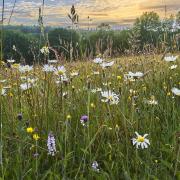A watery wander in Gloucester takes us round a bend in the Severn, to a scared spring above water meadows, and past Llanthony Priory along the canal, taking an unnerving ghost sighting, a sad but beautiful monument and a holy shrine along the way.
To start the walk in the Docks, cross Llanthony Bridge and walk up the tow path towards the priory. Since it was renovated, Llanthony Secunda Priory is a warm and welcoming place. Founded in 1136, St. Mary’s priory was a daughter house of the Augustinian priory at Llanthony in Wales, and a retreat for the canons who were suffering constant raids from the Welsh. The canons liked the good life in Gloucester a lot better, one saying that he wished the ground would swallow up the Welsh house, another saying he wished the stones of the priory would turn into hares and hop away into the mountains! As well as its religious duties it was a well-known cheese producer – and supplied lampreys to the crown. But at the Reformation that all, of course, came to an end.

The priory buildings thereafter had an eventful history. The Royalist army based their artillery there to target the Parliamentarians holding the city in the Civil War. It’s said that the nursery rhyme Humpty Dumpty is based on a huge cannon, that was brought all the way from Holland, in hopes it would destroy the city wall. Unfortunately for the Royalists, it exploded on its first shot – that was Humpty’s big fall! There is, sadly, no evidence that this happening is linked to the rhyme, but for the priory buildings the war was a disaster – the church, already ruinous, was further damaged and its tower pulled down. To add insult to injury, in the 1790s the Gloucester and Sharpness canal was dug through the grounds. After that the remaining structures were used as farm buildings.
In 1974, the council acquired the site and, one day – possibly in the long, hot summer of ’76 – a council official was visiting the site. In the burning heat, he and colleague toured the buildings. When they went through a large stone archway, the officer started to feel odd, but kept on going, thinking it just the heat, asking what this part of the building had been used for. ‘A slaughterhouse,’ came the reply. The officer, despite the heat, found himself shivering, and as he shivered, his vision shifted, and there, in front of him, he saw a huddled group of women and children in old-fashioned clothes, cowering away from him a corner, pulling sackcloth hoods over their faces. It was over in an instant, and he tried to put from his mind, but two days later, back on another visit, he found he was unable to enter the building. As he hovered undecided, in the archway, his colleague saw his hair stand on end in fear. Who were these mothers protecting their children huddled there? Dutch prisoners of war from 1781? Refugees during the siege of Gloucester? The destitute unable to seek alms after the closure of the monasteries? Whatever he had seen, it had given the council officer such a fright that he refused to ever go back again.
From the priory, cross Llanthony Road and head up Sudmeadow Lane, then follow the Severn Way around the snaking bend of the river all the way round to Hempsted, taking in the views of the river and Highnam and the Forest of Dean beyond on the other side. You come out through a gate; head down the bank into a paddock, and, rather than going onto the road, cross through two rather damp water meadows. Shortly after you go into the third field, turn right through a gate onto Rectory Lane and make your way to St. Swithun’s church. In the church you’ll find a beautiful Arts and Crafts stained-glass window by Karl Parsons, one of only two by him in the county – the other in Bibury. It’s dedicated to ‘little Margaret Tew’, the daughter of Edith and Walter Tew, who died aged eight in 1916.

On coming out of the church, follow the footpath through the churchyard. In a little while you’ll see a tiny building all alone on the hill, facing out across the water meadows. This is Lady’s Well, once a healing well, the little wellhouse dating back to the 14th century. It was probably built by the canons of St. Mary’s Priory. Back in the 19th century a hawthorn tree overhung it – was it a holy thorn? It’s not known if it was dedicated to Mary or her mother, St. Anne. Many wells were once dedicated to both saints. There’s a carving of Anne with the young Mary and another figure on the rear of the wellhouse, but there’s a story that goes that this spring was created by none other than Mary herself.
What was the Virgin Mary doing in a field outside Gloucester? After Jesus died the apostles and their friends all set to travelling to spread his word. Joseph of Arimathea, bearing the Holy Grail – the cup from which Christ had drunk during the Last Supper – set off to Britain where once he had brought Jesus when he was little more than a boy. He settled in Glastonbury and, one day, the Virgin decided to visit him. But when she reached Britain, her boat overshot Glastonbury and was caught by a bore wave that carried her up the Severn and deposited her on the banks of the river here! Thirsty after her salty sea adventure, she caused a spring to burst forth – the Lady’s Well.
Mary presumably got back into her boat and sailed south to meet her friend, but we’re going to continue along the footpath to where it joins a lane, then follow that back, crossing Llanthony Road to the Priory and retracing your steps back to the docks. There are many tales that Mary, Jesus and Joseph of Arimathea all walked in Britain’s green and pleasant lands. Even St Augustine of Canterbury wrote to Pope Gregory in the 6th century saying that Mary’s tomb had been found on an island in Britain! In fact, although Glastonbury was associated with Christianity in Britain very early on, the legend of Joseph bringing the Holy Grail there only sprang up in the later Middle Ages. The well may be no more than a simple local shrine whose waters were said to cure all ailments bathed in it – no mean feat in itself.

ESSENTIALS
Distance: 5.5 miles
Duration: 2.5 hours.
Level: Easy, some road walking and some fields may be boggy.
Parking: Gloucester Docks
Toilets and refreshments: Many places to eat in and around the Docks and Gloucester Quays
Transport links: trains to Gloucester, buses 8, 10, 48, 49 serve the docks and Gloucester Quays
Further reading: Gloucestershire Folk Tales, by Anthony Nanson.
LINKS
Route: gb.mapometer.com/walking/route_5439168
Llanthony Priory: llanthonysecunda.org
Lady’s Well: megalithic.co.uk/article.php?sid=8250
Kirsty Hartsiotis is based in Stroud and available for hire as a storyteller and speaker. She is an Accredited Arts Society lecturer. Her books include Wiltshire Folk Tales and (with Anthony Nanson) Gloucestershire Ghost Tales and Gloucestershire Folk Tales for Children. She is also the curator of decorative art at a Gloucestershire museum.



























